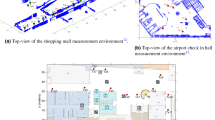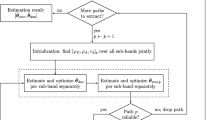Abstract
The recent interest in ultra-wideband (UWB) systems requires an accurate modelling of the radio channel characteristics. Among these, the fading properties of the UWB channel are of particular interest in the development of the air interface. This paper reports on an experiment designed to study spatial and temporal fluctuations of the UWB signal conjoindy in the 3.1 to 11 GHz frequency band, in a typical indoor office environment. The proposed analysis of the small-scale amplitude distribution shows significant differences between the two concepts and provides novel results that complement the available studies.
Preview
Unable to display preview. Download preview PDF.
Similar content being viewed by others
References
P. Pagani and P. Pajusco, Experimental assessment of the UWB channel variability in a dynamic indoor environment, in Proceedings of the IEEE International Symposium on Personal, Indoor and Mobile Radio Comm., Barcelona, Spain, September 2004.
D. Porcino and W. Hirt, Ultra-wideband radio technology: Potential and challenges ahead, IEEE Commun. Mag., 41(7), 66–74 (2003).
R. J.-M. Cramer, R. A. Scholtz, and M. Z. Win, Evaluation of an ultra-wide-band propagation channel, IEEE Trans. Antennas Propag., 50(5), 561–570 (2002).
R. M. Buehrer, W. A. Davis, A. Safaai-Jazi, and D. Sweeney, Characterization of the ultra-wideband channel, in Proceedings of the IEEE Conference on Ultra Wide Band Systems and Technologies, Reston VA, USA, November 2003, pp. 26–31.
R. Kattenbach and H. Früchting, Investigation of the impacts of moving scatterers by wideband measurements of time-variant indoor radio channels, in Proceedings of the COST 273 Workshop, Bologna, Italy, Document TD(01)033, October 2001.
P. Hafezi, A. Nix, and M. A. Beach, An experimental investigation of the impact of human shadowing on temporal variation of broadband indoor radio channel characteristics and system performance, Proceedings of the IEEE 52nd Vehicular Technology Conference, Boston, MA, USA, vol. 1, September 2000, pp. 37–42.
J. Kunisch and J. Pamp, Reconstruction of UWB indoor radio wave propagation, Whyless.com Project, September 9, 2003; http://www.whyless.org.
Author information
Authors and Affiliations
Editor information
Editors and Affiliations
Rights and permissions
Copyright information
© 2007 Springer Science+Business Media, LLC
About this chapter
Cite this chapter
Pagani, P., Pajusco, P. (2007). On the Fading Properties of a UWB Link in a Dynamic Environment. In: Sabath, F., Mokole, E.L., Schenk, U., Nitsch, D. (eds) Ultra-Wideband, Short-Pulse Electromagnetics 7. Springer, New York, NY. https://doi.org/10.1007/978-0-387-37731-5_86
Download citation
DOI: https://doi.org/10.1007/978-0-387-37731-5_86
Publisher Name: Springer, New York, NY
Print ISBN: 978-0-387-37728-5
Online ISBN: 978-0-387-37731-5
eBook Packages: Physics and AstronomyPhysics and Astronomy (R0)




